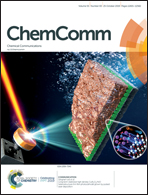Enhanced in situ detection and imaging of lipids in biological tissues by using 2,3-dicyanohydroquinone as a novel matrix for positive-ion MALDI-MS imaging†
Abstract
A fluorescent dye, 2,3-dicyanohydroquinone (DCH), was optimized for use as a new matrix for positive-ion MALDI-MS imaging, and it provided enhanced lipid detection and imaging in biological tissues. The properties of DCH, include a strong ultraviolet absorption, low volatility in a high-vacuum (∼10−7 mbar) source, super chemical stability, μm-sized matrix crystals, uniform matrix deposition, and high ionization efficiency for the detection of lipids.



 Please wait while we load your content...
Please wait while we load your content...